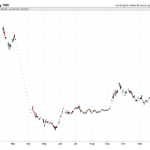Imagine watching the price of silver plummet before your eyes. You wonder why this precious metal, once so highly valued, is now dropping in price.
In this article, we will delve into the economic factors that are impacting the silver market. From changes in supply and demand dynamics to the influence of global trade wars, we will analyze the reasons behind this downward trend.
Get ready to uncover the truth behind the dropping price of silver.
Key Takeaways
- The strong economy is leading to a decreased demand for silver, which is causing the price to drop.
- Factors such as inflation, interest rates, and currency exchange rates are influencing silver prices, and low inflation is reducing the value of silver as a hedge against inflation.
- A decrease in supply or an increase in demand leads to a rise in silver prices, while an excess of silver in the market or a shortage of silver causes the price to drop or rise respectively.
- Trade wars can lead to higher tariffs and trade restrictions, reducing overall demand for silver. Economic uncertainty during trade tensions also causes investors to seek safe-haven assets like gold, decreasing demand for silver. Additionally, trade wars can impact global manufacturing and trade, reducing the demand for silver in industries.
Economic Factors Affecting Silver Prices
You should consider the impact of economic factors on the current drop in silver prices.
The global economy plays a significant role in determining the price of silver. When the economy is strong, investors tend to move away from safe-haven assets like silver and invest in riskier assets with higher potential returns. This shift in investor sentiment leads to a decrease in demand for silver and subsequently lowers its price.
Additionally, economic indicators such as inflation, interest rates, and currency exchange rates also influence silver prices. For example, if inflation is low, the value of silver as a hedge against inflation decreases, which can contribute to a drop in prices.
Understanding these economic factors is crucial in comprehending the current decline in silver prices and how they interact with changes in supply and demand dynamics.
Changes in Supply and Demand Dynamics
It’s important to understand how changes in supply and demand dynamics can affect the market for silver. When the supply of silver increases or the demand for silver decreases, the price of silver tends to drop. Conversely, when the supply of silver decreases or the demand for silver increases, the price of silver tends to rise.
To illustrate this concept, let’s take a look at the following table:
| Supply of Silver | Demand for Silver |
|---|---|
| Increases | Decreases |
| Decreases | Increases |
In the first scenario, if the supply of silver increases, but the demand for silver decreases, there will be an excess of silver in the market, leading to a drop in price. In the second scenario, if the supply of silver decreases, but the demand for silver increases, there will be a shortage of silver, causing the price to rise.
Understanding these dynamics is crucial to comprehending the impact of global trade wars on the silver market.
Impact of Global Trade Wars on Silver Market
Understanding the impact of global trade wars on the market for silver is crucial in comprehending the changes in supply and demand dynamics. Here are four key points to consider:
- Tariffs and trade restrictions: Trade wars can lead to higher tariffs and trade restrictions, which can disrupt the flow of silver across borders. This can result in a decrease in global silver trade and a reduction in overall demand.
- Economic uncertainty: Trade tensions can create economic uncertainty, causing investors to seek safe-haven assets like gold. As silver is often considered a more speculative investment, it may experience a decline in demand as investors turn to other alternatives.
- Industrial demand: Silver has various industrial applications, including electronics, solar panels, and medical devices. Trade wars can impact global manufacturing and trade, which may reduce the demand for silver in these industries.
- Currency fluctuations: Trade wars can lead to currency fluctuations, affecting the cost of silver production and trade. This can impact the profitability of silver mining companies and potentially decrease the supply of silver in the market.
Understanding these factors can help explain the recent changes in the silver market. However, investor sentiments and speculative trading also play a significant role, which will be discussed in the next section.
Investor Sentiments and Speculative Trading
Investors’ sentiments and speculative trading can greatly influence the dynamics of the silver market. When investors are optimistic and have a positive outlook on the economy, they are more likely to invest in silver, driving up its price. On the other hand, when investors are pessimistic and uncertain about the future, they tend to sell off their silver holdings, causing the price to drop.
Speculative trading also plays a significant role in the silver market. Speculators buy and sell silver contracts based on their expectations of future price movements, rather than for physical delivery. Their actions can create volatility and impact the overall price of silver.
To better understand the relationship between investor sentiments, speculative trading, and the silver market, let’s take a look at the following table:
| Investor Sentiments | Speculative Trading | Silver Market |
|---|---|---|
| Positive | High | Bullish |
| Negative | High | Bearish |
| Positive | Low | Neutral |
| Negative | Low | Neutral |
| Neutral | High | Volatile |
As shown in the table, when investor sentiments are positive and speculative trading is high, the silver market tends to be bullish. Conversely, when investor sentiments are negative and speculative trading is high, the market tends to be bearish. When speculative trading is low, regardless of investor sentiments, the market is more likely to be neutral. Additionally, when speculative trading is high and investor sentiments are neutral, the market can become volatile.
Role of Central Banks in Silver Price Movements
When central banks intervene in the silver market, they can have a significant impact on the dynamics of the price. Here’s why:
- Monetary Policy:
- Central banks use various monetary policy tools to control inflation and stabilize the economy.
- By adjusting interest rates, they influence borrowing costs, which in turn affects investor demand for silver.
- Reserve Management:
- Central banks hold significant amounts of silver as part of their foreign exchange reserves.
- Buying or selling silver in large quantities can create price movements and affect market sentiment.
- Currency Strength:
- Central banks also play a role in determining the strength of their national currency.
- A stronger currency can make silver more expensive for foreign buyers, leading to lower demand and potentially lower prices.
- Market Stability:
- Central banks monitor market conditions and intervene to maintain stability.
- By injecting liquidity or implementing regulations, they aim to prevent excessive price volatility in the silver market.
Understanding the role of central banks in the silver market can provide insights into the factors driving price fluctuations.





